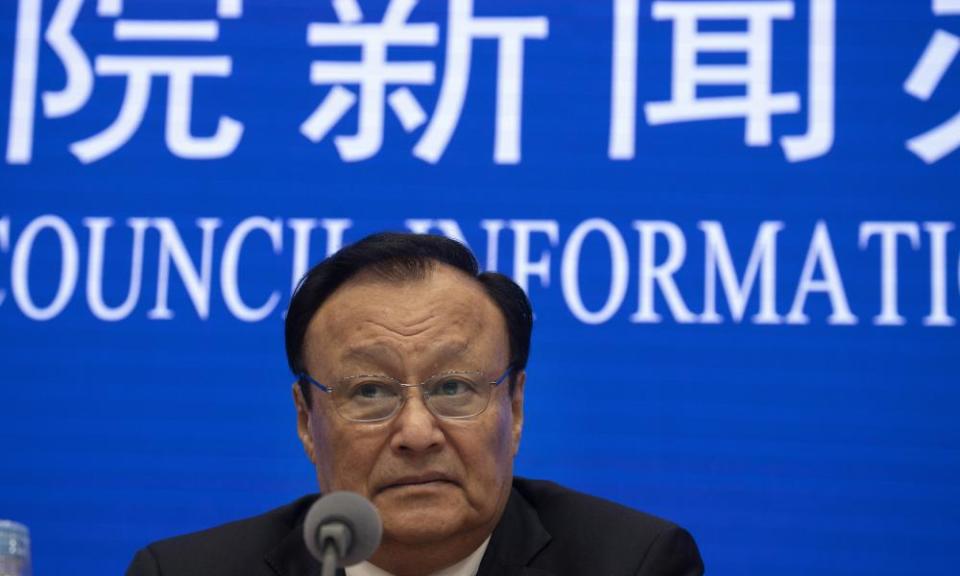China claims detained Uighurs have been freed

China has said Uighurs and other minorities believed to be detained in Xinjiang have been freed, repeating claims made previously but offering no evidence of their release.
In response to growing international criticism of the detention of up to 1.5 million people in re-education and other internment camps, the Xinjiang governor, Shohrat Zakir, told reporters in Beijing that they had “returned to society”.
China has long said it does not run what witnesses and human rights advocates have described as re-education camps, where detainees are forced to undergo political indoctrination, but offers free “vocational training” to residents who attend voluntarily.
Related: 'Allow no escapes': leak exposes reality of China's vast prison camp network
Zakir said on Monday: “At present, all the trainees who participated … have completed their studies, found stable employment with the help of the government and have improved their quality of life and live a happy life.”
He said the programme focused on teaching Chinese language skills, law and vocational skills to “eliminate extremism”.
However, classified government documents seen by a media consortium, including the Guardian, have undermined those claims. The documents outline a strategy to detain ethnic minorities who have not committed crimes for the sake of “educational transformation”. The directives include security measures to ensure “no escapes” and that “students” should be held for at least one year.

Uighurs and Kazakhs outside China have told the Guardian their family members in Xinjiang remain detained in camps. Those who are not in the camps are subject to constant surveillance, including having Chinese officials living in their homes, and live under the threat of being sent to a centre.
The Uighurs are a predominantly Muslim Turkic-speaking ethnic group, primarily from China’s northwestern region of Xinjiang. They have been subject to religious and ethnic persecution by Chinese authorities, with rights groups claiming that in recent years more than 1 million people have been held in detention camps.
Having initially denied the existence of the camps, China has described them as “vocational education centres” in the face of mounting evidence in the form of government documents, satellite imagery and testimonies from escaped detainees. Satellite images have also suggested that more than two dozen Islamic religious sites have been partly or completely demolished since 2016.
In July 2019 China claimed that most of the people sent to the mass detention centres have “returned to society”, but this has been disputed by relatives of those detained. Around 1-1.5m Uighur are estimated to live overseas as a diaspora, many of whom have campaigned against the treatment of their families. China repeated these claims in December 2019, but offering no evidence of their release.
Zakir said those reports were “pure fabrication” but declined to give the number of people attending the centres. He said the number who took part was “dynamic” and could not be estimated.
In recent days, Beijing has launched an aggressive propaganda campaign in response to criticism of its policies in Xinjiang. Last Friday the state broadcaster CCTV released a documentary called Fighting Terrorism in Xinjiang, which included footage of terrorist attacks. Over the last year, China has put on several curated, state-organised trips to the region.
The remarks represent an escalation in rhetoric directed at the US, as Washington and Beijing remain locked in a trade war form more than a year. Beijing has also labelled the US a “black hand” behind ongoing anti-government protests in Hong Kong.
The roots of the dispute come from US president Donald Trump’s “America first” project to protect the US’ position as the world’s leading economy, while encouraging businesses to hire more workers in the US and to manufacture their products there.
Trump complains of a large trade deficit with China, which he views as a symbol of the US’s decline as a manufacturing powerhouse. Chinese imports to the US totalled $539.5bn last year, while $120.3bn was sold the other way – leaving a trade deficit of $419.2bn.
The president has accused Beijing of “unfair” trade policies, including allowing the theft of US companies’ intellectual property. The threat of import tariffs on Chinese goods is being used as leverage in talks where Trump is seeking changes to Beijing’s trade policy.
Tariffs have been imposed by Washington on some Chinese goods sold in the US for about a year. They came on top of broader tariffs used by Trump that have hit China and other trading partners such as the EU, Canada and Mexico, on goods including steel and aluminium.
In May 2019 the US president further ratcheted up existing import tariffs of 10% on $200bn (£153bn) of Chinese goods sold in the US to 25%, hitting everything on a long list of products. Trump has previously warned that 25% tariffs could be slapped on a further $325bn of goods – which would mean all Chinese imports being covered by tariffs.
However, talks in November 2019 aimed at easing tensions were welcomed as the beginning of a thaw in the trade war between the two nations.
Richard Partington and Jasper Jolly
Last week, US politicians passed legislation that would sanction Chinese officials involved in the crackdown in Xinjiang.
Zakir said: “The US is getting restless and has launched a smear campaign against Xinjiang. But no force can stop Xinjiang’s progress toward stability and development.
“When the lives of people of all ethnic groups in Xinjiang were seriously threatened by terrorism, the US turned a deaf ear. Now that Xinjiang is steadily developing and people of all ethnicities are living and working in peace, the US feels uneasy, and attacks and smears Xinjiang.”

 Yahoo News
Yahoo News 
